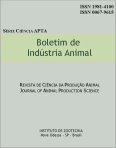Paspalum guenoarum seed production; harvesting time and nitrogen fertilization
Abstract
An experiment was carried out during two consecutive years at Itapetininga, State of São Paulo, Brazil, in order to study the effects of N rates and harvest times on the seed yield of Paspalum guenoarum Arech. var. guenoarum.Three N rates (0, 75 and 150 kg N.ha-1) and ten harvest times were the treatments. Those treatments were completely randomized with three replications, in a split-plot design. Nitrogen rates were the plots and the harvest time were the subplots (12 m2 each). The first harvest was set at 14 days after the initial flowering date (IF) which was defined as the presence of 5 to 10 inflorescence.m-2 (at least one raceme free of the flag Ieaf). Other harvest were performed wokly. Total seed yield (TS), pure seed yield (PS), pure viable seed yield (PVS), purity (P) and germination (G) were evaluated. In the first year the interaction harvest time x N rates was significant (P < 0.05) for the PS and PVS. The highest values for PS and PVS were observed at 56 days after IF (7th harvest) at an N rate. Nitrogen had a significant effect (P < 0.01) only at the 9th harvest, when the seed yield was very low. In the second year the interaction harvest time x N rate was significant for TS (P < 0.05) and the other variables (P < 0.01). Nitrogen fertilization increased TS and PS at the 6th (P < 0.01) and 7th (P < 0.05) harvest, respectively 49 and 56 days after IF. The highest values for PVS were observed in the 5th (P < 0.05), 6th and 7th (P < 0.01) harvest. The highest pure seed yield, when no N fertilizer was used, was obtained in the 5th harvest (42 days after IF) and in the 6th harvest (49 days after IF) when 75 or 150 kg N.ha-1 was applied.Downloads
Downloads
Published
Issue
Section
License
Os autores não serão remunerados pela publicação de trabalhos, pois devem abrir mão de seus direitos autorais em favor deste periódico. Por outro lado, os autores ficam autorizados a publicar seus artigos, simultaneamente, em repositórios da instituição de sua origem, desde que citada a fonte da publicação original seja Boletim de Indústria Animal. A revista se reserva o direito de efetuar, nos originais, alterações de ordem normativa, ortográfica e gramatical, com vistas a manter o padrão culto da língua e a credibilidade do veículo. Respeitará, no entanto, o estilo de escrever dos autores. Alterações, correções ou sugestões de ordem conceitual serão encaminhadas aos autores, quando necessário. Nesses casos, os artigos, depois de adequados, deverão ser submetidos a nova apreciação. As opiniões emitidas pelos autores dos artigos são de sua exclusiva responsabilidade. Todo o conteúdo deste periódico, exceto onde está identificado, está licenciado sob a Licença Creative Commons Attribution (CC-BY-NC). A condição BY implica que os licenciados podem copiar, distribuir, exibir e executar a obra e fazer trabalhos derivados com base em que só se dão o autor ou licenciante os créditos na forma especificada por estes. A cláusula NC significa que os licenciados podem copiar, distribuir, exibir e executar a obra e fazer trabalhos derivados com base apenas para fins não comerciais.













